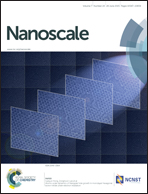A tactile sensor translating texture and sliding motion information into electrical pulses†
Abstract
An electric pulse output by a nanogenerator upon a strain-and-release event resembles a neural impulse. Cutaneous receptors imbedded in skin transduce mechanical forces impinging the skin into neural impulses and the tactile information is encoded into the firing rates of the neural impulses. Here, we report a nanogenerator-type tactile sensor, which records the texture and sliding motion by outputting a sequence of electric pulses. The sensitive component of the device is an NG embedded in a polydimethylsiloxane package. An artificial finger-print serving as a strain introducer mimicking finger prints is integrated over the NG. The electric pulses outputted by the device transmit the texture and sliding motion information. The device demonstrates a capability of detecting punch holes with depth less than 200 μm on a nonwoven cloth. It also shows a perfect reproducibility of the electric pulses as it scans the same area of a band wire and a piece of nonwoven cloth. The artificial finger-print is the key element in transferring the strain direction, which allows the active sensor (a nanogenerator) beneath to detect the bumpy structure during a touch and sliding motion.


 Please wait while we load your content...
Please wait while we load your content...